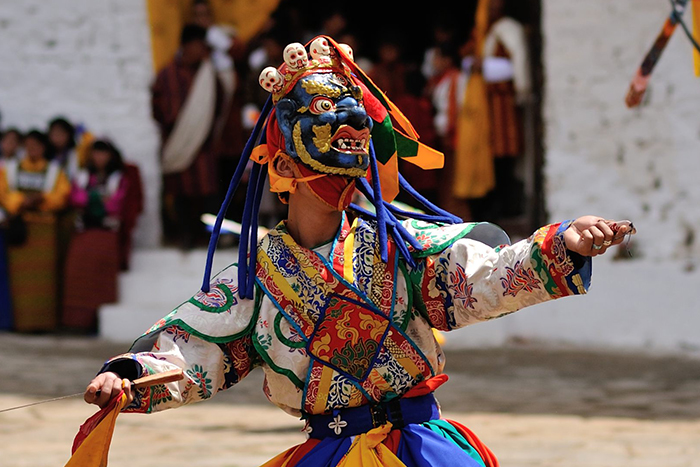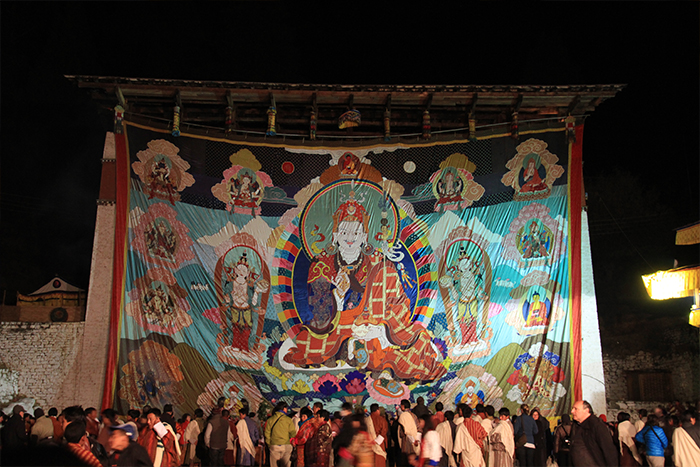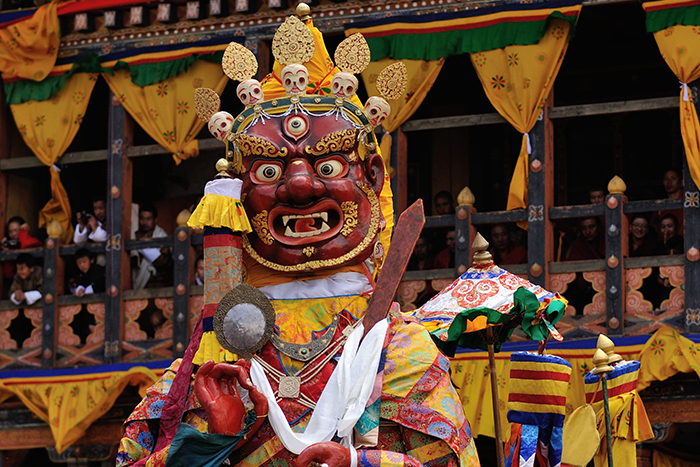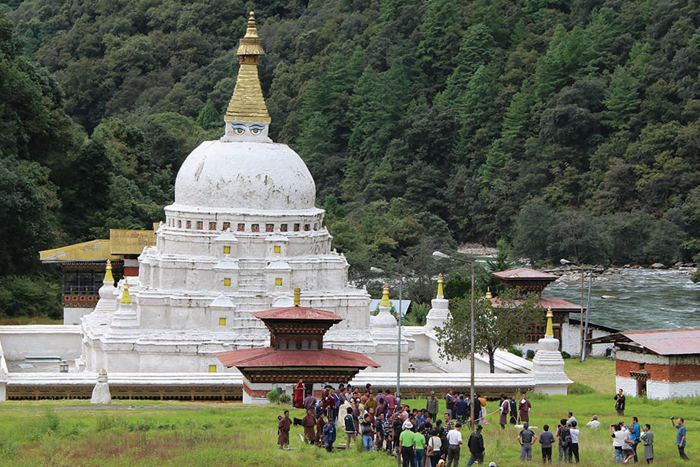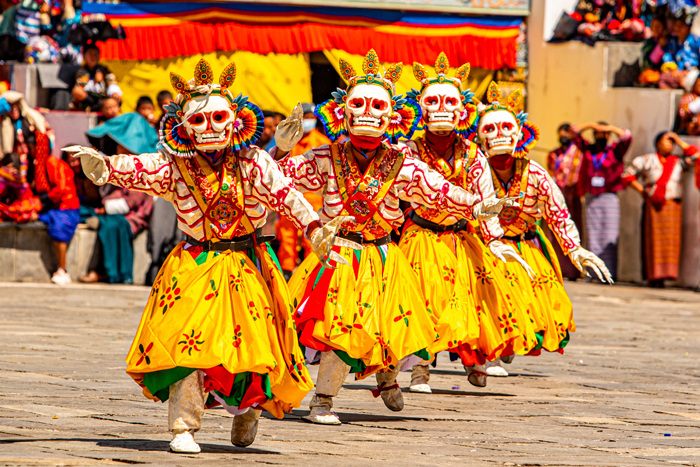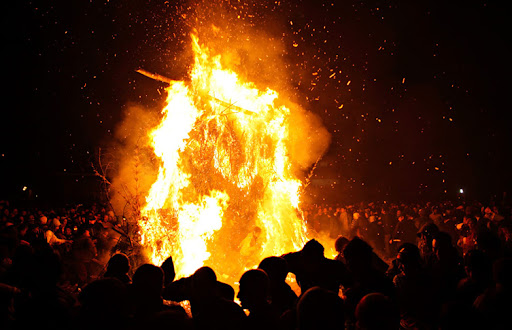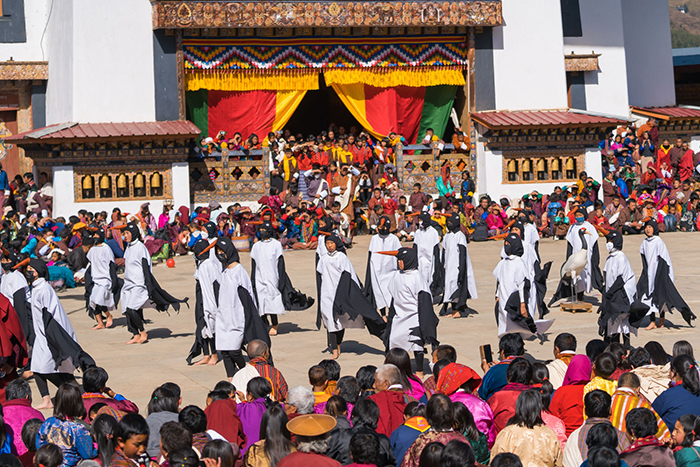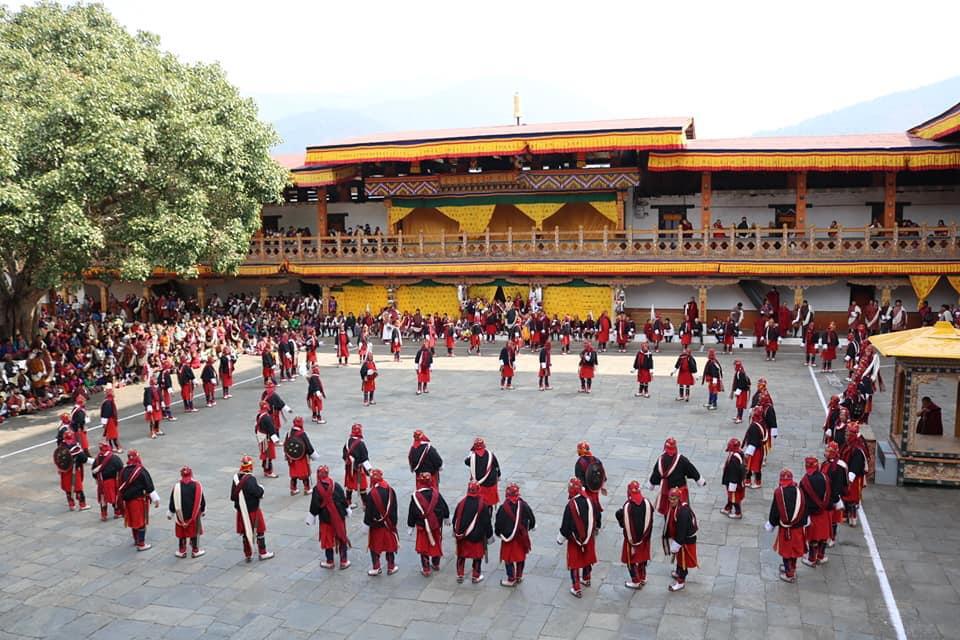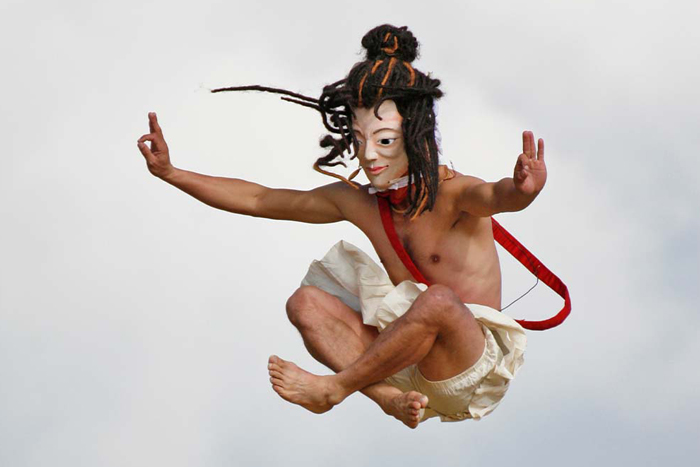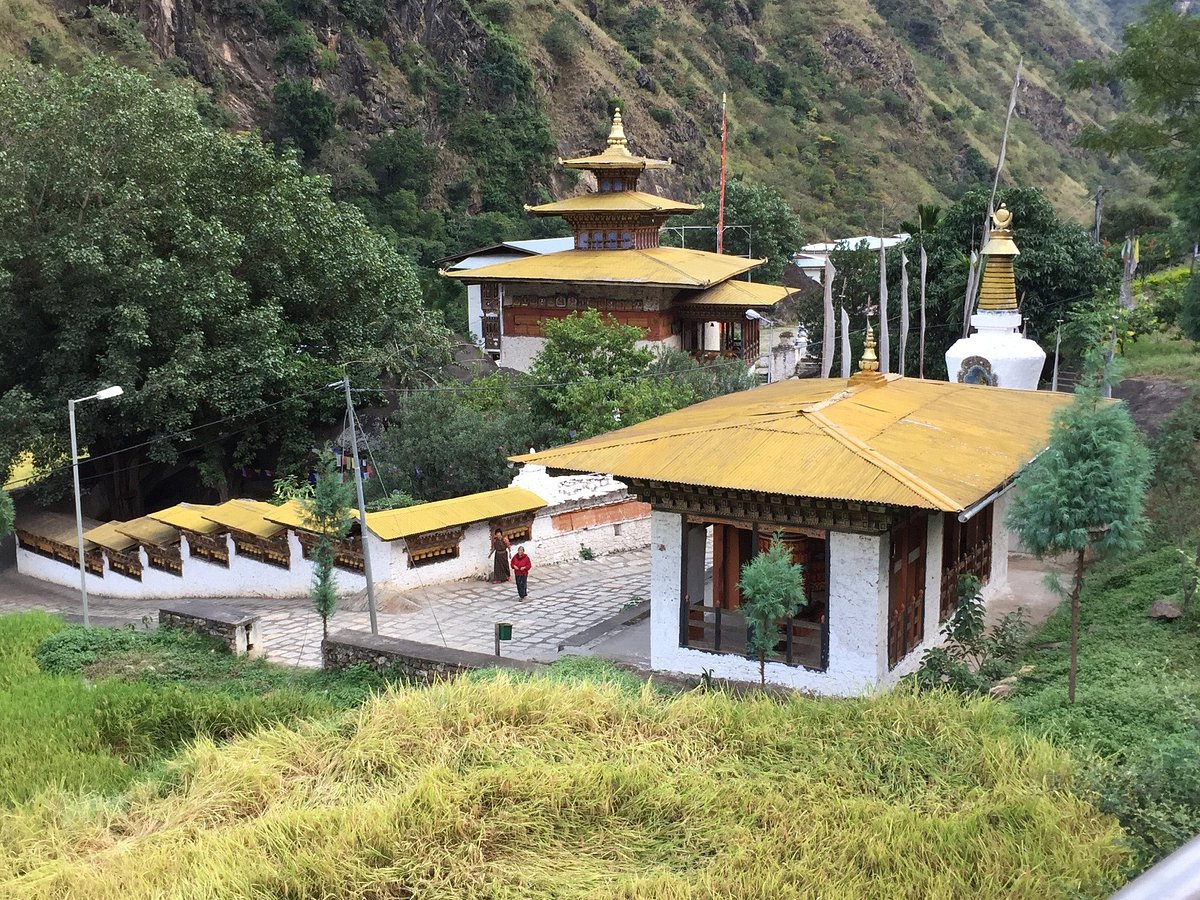Paro Tshechu
$800





Tour Summary
Started by Zhabdrung Ngawang Namgyal, and Penlop Rigzin Nyingpo during the consecration of Paro Dzong in 1644, Paro Tshechu is one of the biggest festivals in the Bhutanese calendar. It is observed in three parts - the pre-festival rituals on the first day, ceremonies on the second day inside the Paro Dzong, and the main festival at the festival ground for three days. Bhutanese from all walks of life in their finery come to attend the five-day festival. A special event in all Tsechus is the unfurling of the Thongdrol, meaning “Liberation at Sight.” This comes from the belief that seeing an aesthetically proportioned Buddhist image plants a seed of enlightenment in the viewer’s heart. That seed matures into the liberation of one’s mind and frees us from endless rebirths of suffering. Thongdrol also means large silk appliqué thangkas (painting) that are displayed for a few hours during important religious ceremonies in Bhutan. The sacred Thongdrol of Guru Rinpoche is displayed early in the morning on the last day of the Tshechu. On such occasion, the festival venue fills with people at dawn in freezing cold.
Exit and Entry: Paro
Venue: Paro Dzong Courtyard
Day 01: Paro: Arrive at Paro (2280m)
The flight is exhilarating to say the least, as the route traverses parallel to the mighty Himalayas enabling passengers to see the world’s highest peak, Mt Everest, and many more. The descent affords a panoramic view of Bhutan’s foothills culminating into a thrilling landing at what is considered one of the world’s most challenging airports.
Meet your guide at the airport and head to the hotel for lunch. Devote the afternoon to sightseeing around the Paro valley famed for its natural beauty, historical monuments, agricultural farms and quintessentially Bhutanese village communities. Visit the National Museum, formerly a watch tower, and then the Castle on a Heap of Precious Jewels or Rinpung Dzong. Wind up the day with a stroll around Paro town. Overnight at the hotel.
Day 02: Paro-Excursion to Taktsang
After early breakfast drive to the Ramthangka (base camp) of Taktsang. The five-hour round trip follows an ancient but oft-trodden footpath flanked by water-driven prayer wheels.
The temple, precariously perched on a hair-raising ravine about 1,000 metres above the valley floor, is considered sacrosanct as it was in a cave within this temple that the eight century tantric saint, Padmasambhava, subdued the evils who obstructed the teachings of the Buddha. The saint is believed to have come to Taktshang in a fiery wrathful form riding a tigress. Over the years, many Buddhist saints have meditated in and around the temple and discovered numerous hidden treasure teachings.
Visit the ruins of Drugyel Dzong enroute. The fortress known as the “Castle of the Victorious Drukpa”, is a symbol of Bhutan’s victory over the Tibetan invasions in the 17th and 18th centuries. We can also get a view of the sacred mountain, Jumolhari, along the way. On the way back to our hotel, we will visit the 7th century Kyichu Temple, believed to have been built on a place that resembled a knee of a giant ogress.
Day 03: Whole day witness the Paro festival.
Day 04. Paro - Thimphu: Witness the festival in the morning and drive to Thimphu, Bhutan’s capital city in the evening. Overnight in Hotel.
Day 05: Thimphu Sojourn
In the morning we will visit places of cultural and historical office in the capital.
Memorial Chorten (Stupa): Your day will begin with visits to the Memorial Chorten, one of Bhutan’s most beautiful stupas built in memory of the Father of Modern Bhutan, Third King Jigmi Dorji Wangchuck.
Buddha Point: The next visit will be to Buddha Point, where the gigantic Buddha Statue stands.
Changangkha Lhakhang: A 13th century monastery, built by Phajo Drugom Shigpo and later embellished by his son Nyima, the monastery is believed to be the protector of all people born in the Chang valley.
Others: We will also be visiting the Takin Zoo, taking a drive to Sangaygang, a point from where you can have a bird’s eye view of Thimphu valley, Handicraft’s center, the Local Bhutanese Paper making factory, a Nunnery and the Arts and Craft School.
After lunch we move to Punakha, a drive of about 3 hours. In about 45 minutes, we will reach the Dochula Pass (3,100m).
Tashichho Dzong: The country’s main secretariat building, built in 1642, it is today the hub of Bhutanese polity. This massive structure houses the office of the King, the Throne Room, some government Ministries and the State Monastic Body. It is also the summer residence of the Chief Abbot and senior monks.
Day 06: Thimphu-Punakha
The three to four-hour drive from Thimphu traverses thorough a constantly changing kaleidoscope of vegetation, waterfalls, flowers, mountains and meadows. In about 45 minutes we will reach the famous Dochula pass (3,100m) where on a clear day we can see the entire eastern Himalayan range, teeming with 6,000m to 7,554m snow-capped mountains. The pass also known for its abundant species of extremely beautiful flowers has 108 Buddhist stupas exquisitely built around a mound, adding to the natural splendor of the place.
From the pass we descend to the sub-tropical valley of Punakha. Punakha served as the ancient capital of capital and still possesses the country’s main treasures in the form of Buddhist relics. Resembling a gigantic ship on an ocean floor from afar, and girdled by two (Male and Female) rivers, the castle-fortress also represents the best specimen of Bhutanese architecture.
On the way visit Chhimi Lhakhang, founded by Lama Dukpa Kinley also known as the “Divine Mad Man.” It is half an hour walk across a local village and rice field. After lunch visit Punakha Dzong-built in 1637 by Zhabdrung. It is one of the most beautiful Dzongs in the country.
Overnight at Hotel.
Day 07: Punakha-Thimphu
After breakfast drive towards the north of Punakha valley and start the hike to Khamsum Yuelley Namgyal Chorten, an hour round trip. After lunch, drive to Thimphu.
Overnight at hotel.
Day 08. Departure from Bhutan
After breakfast, drive to Paro international airport for your onward flight. Our representative will see you off.
|
GROUP SIZE: Any group Size |
TOUR MONTHS: 4th - 8th April |
Minimum Daily Package Inclusions
⇒ Accommodation in 3 stars approved hotels
⇒ US$ 40 per person visa fees (single entry only)
⇒ Visa arrangement for your stay in Bhutan as per the itinerary
⇒ 35% SDF – Sustainable Development Fees
⇒ Meals – breakfast, lunch and dinner
⇒ English speaking licensed tour guide
⇒ Transfers and sightseeing as per the itinerary, check vehicles
⇒ Entrance, museums and park fees indicated in the itinerary
⇒ Bottled drinking water throughout the journeys
Minimum Daily Package Exclusions
⇒ Flight Fares of any kind (domestic or international)
⇒ Personal Expenses, phone calls, laundry, shopping, etc
⇒ Gratitude or Tipping
⇒ Single Room Supplement
⇒ 4 stars & 5 stars Hotels/Resorts
⇒ Language Speaking Guide
⇒ Travel and Medical Insurance
⇒ Extra Activities Cost (Cycling, Motorbike, River Rafting, Horse Ride, etc)
Related Tour
-
Chorten Kora Tshechu
Unlike other festivals, this is one where...
$1500 -
Thimphu Tsechu
Festivals are the biggest tourist attractions. Religious...
$500 -
Jambay Lhakhang Drup
The Naked Dance of Jampa Lhakhang Drub...
$1100 -
Black Necked Crane Festival
This is an expedition that will bring...
$600 -
Punakha Tshechu
One of the biggest festivals in the...
$600 -
Druk Wangyel Tshechu
Druk Wangyel Tshechu is a one day...
$500 -
Gomphu Kora Tshechu
The Kora festival at Gomphu Kora was...
$1400


